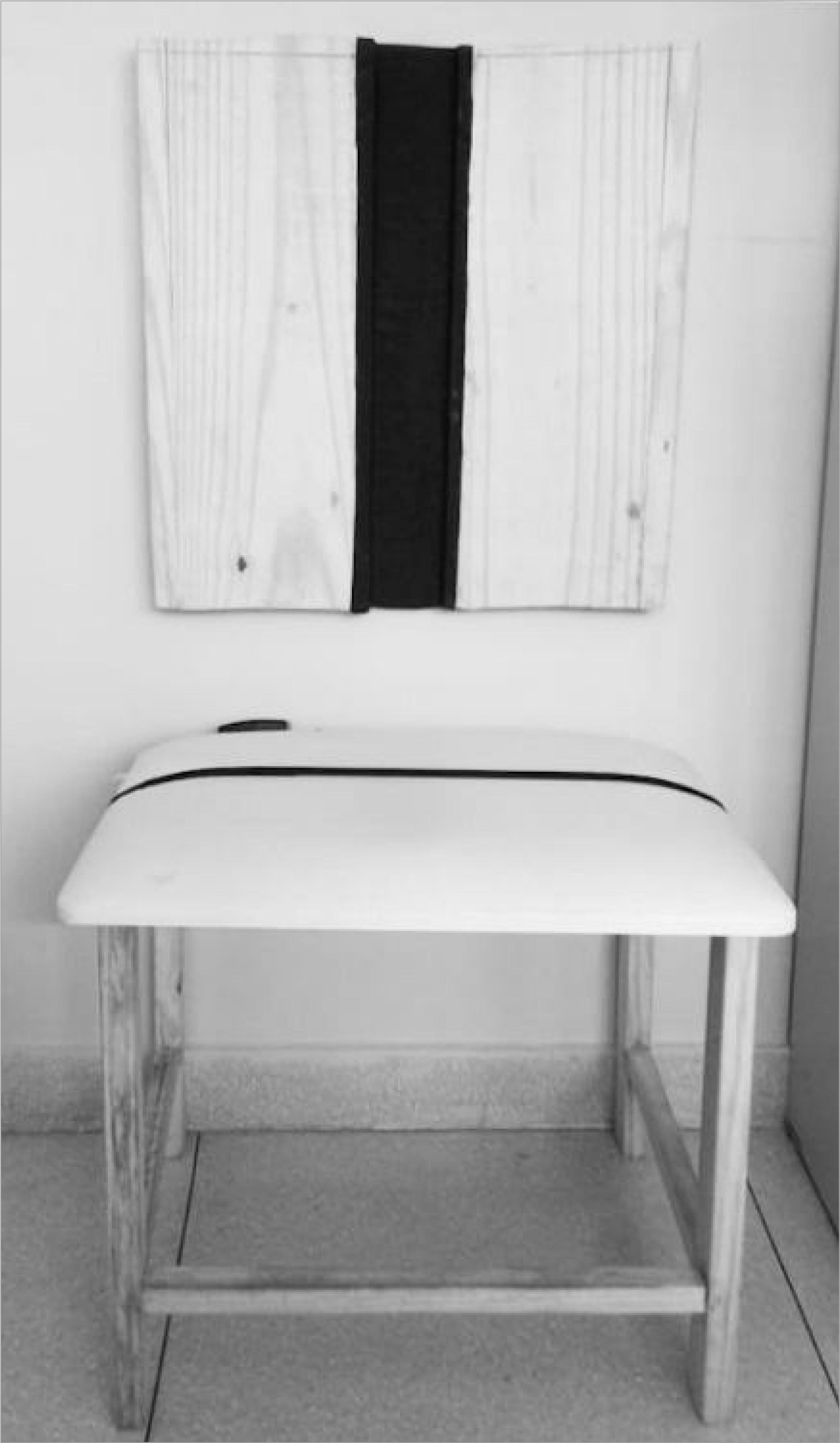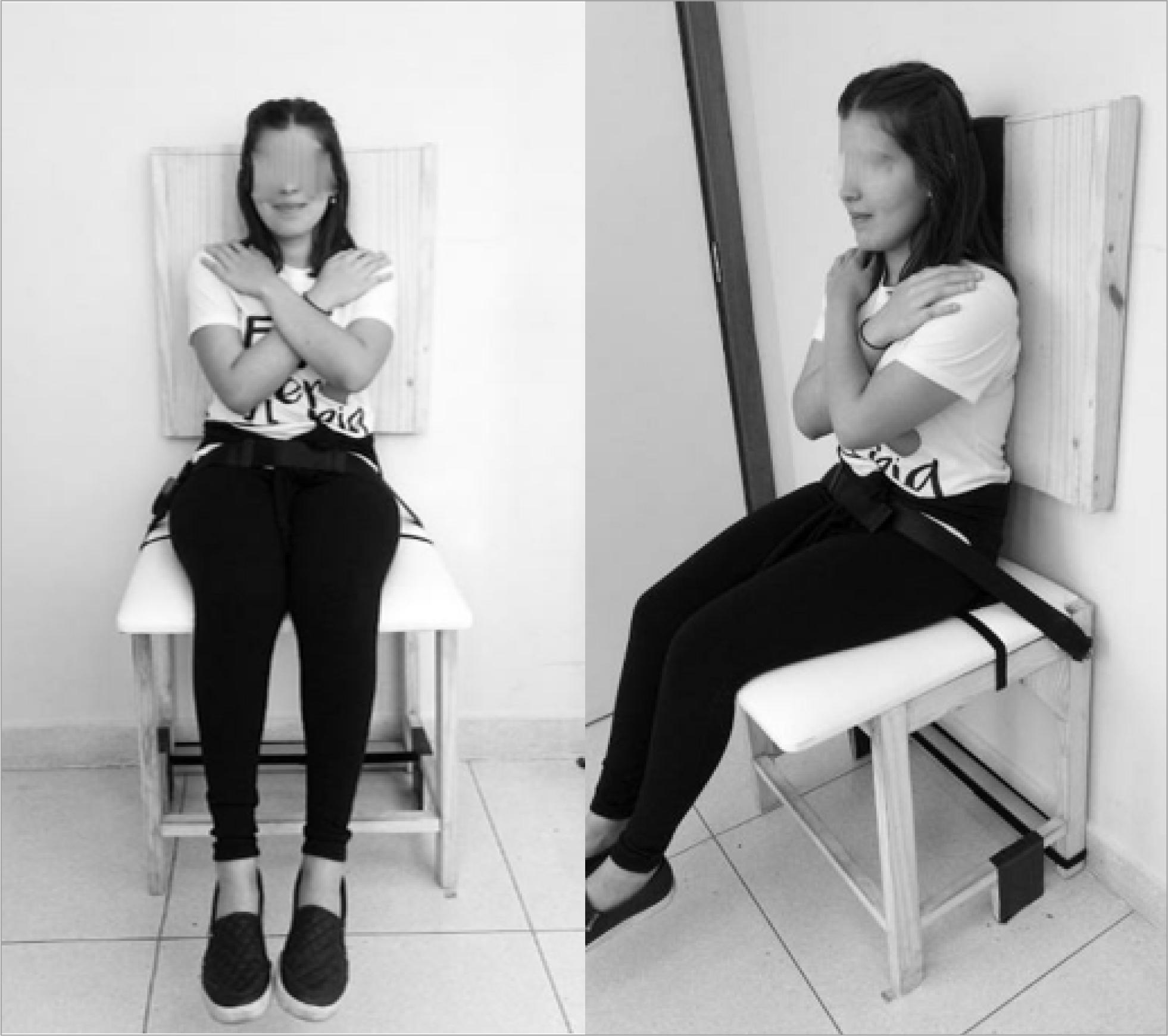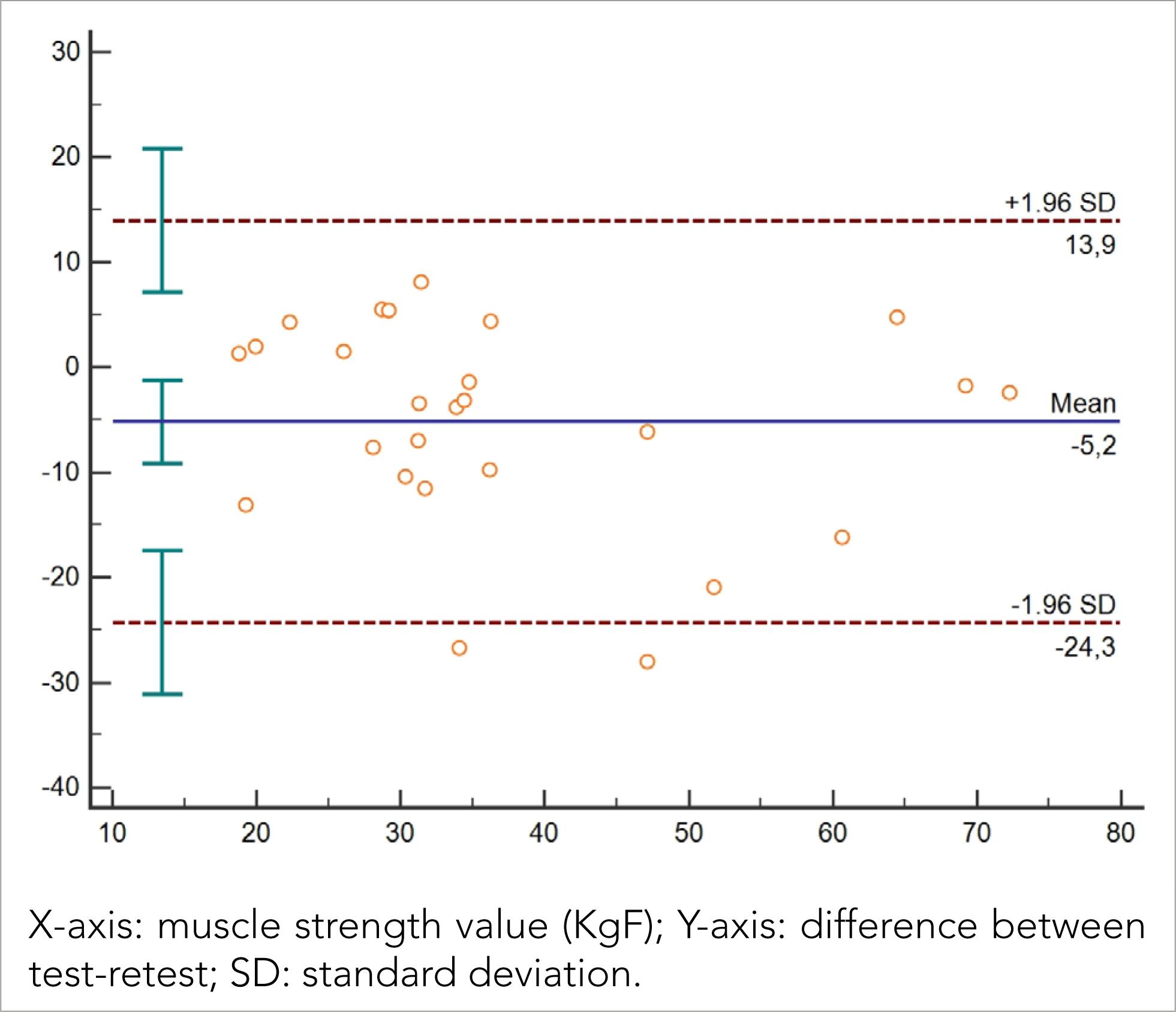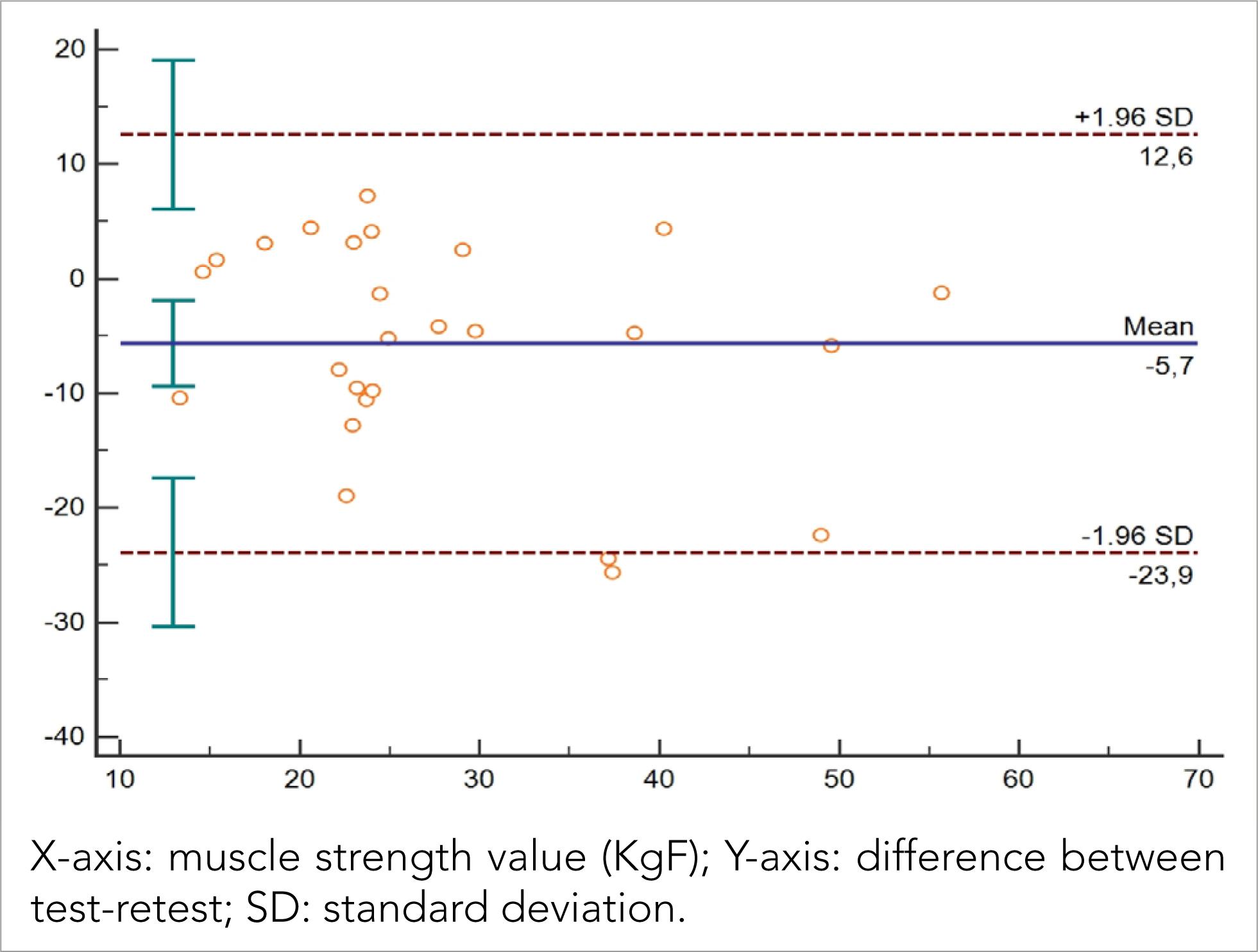INTRODUCTION
Low back pain is one of the most common musculoskeletal condition worldwide (Hoy et al., 2012). Moreover, it is the condition that demonstrates the highest level of disability (James et al., 2018). Therefore, the muscular performance of the lumbar spine is frequently assessed in studies since individuals with chronic nonspecific low back pain may present a high level of weakness and fatigue muscle compared to healthy individuals (Villafañe et al., 2016). Also, low back pain can affect young individuals, adults, and older adults, being most common between 30 and 60 years, being a significant determinant for absence from work (Yahia et al., 2010; Singh, Bailey, & Lee, 2013; James et al., 2018). Thus, strengthening the trunk muscles plays an important role in preventing and rehabilitating spine musculoskeletal dysfunctions.
Consequently, reliable evaluations of the strengthening of the trunk are necessary to define parameters for the rehabilitation process correctly. Due to the importance of muscle evaluations, some systematic review studies have already investigated the reliability of trunk performance tests. However, the majority of studies use muscular resistance as a way to infer the strength of this musculature (Demoulin, Vanderthommen, Duysens, & Crielaard, 2006; Carlsson & Rasmussen-Barr, 2013; Demoulin et al., 2016; Denteneer et al., 2018; Villafañe et al., 2016).
In another way, for an objective measurement of muscular force, the literature recommends the use of an isokinetic dynamometer, considered the gold standard in the evaluation of muscle strength in an open kinetic chain, for several body segments (Caruso, Brown, & Tufano, 2012; Zapparoli & Riberto, 2017) and health conditions (Pua, Bryant, Steele, Newton, & Wrigley, 2008; Jørgensen, Dalgas, Wens, & Hvid, 2017; Kristensen, Stenager, & Dalgas, 2017). However, due to the sophisticated technological characteristics and high cost of purchase and maintenance (Mavroidis et al., 2005), the use of isokinetic equipment is almost always restricted to the research environments, being almost inaccessible to all health professionals in clinical settings. Therefore, the handheld dynamometer is alternative equipment to substitute the isokinetic dynamometer (Kolber & Cleland, 2005; Bohannon, 2006), which is easy to handle, portable, and has a low purchase cost. The validity of the handheld dynamometer in relation to the isokinetic dynamometer and its reliability was demonstrated after a systematic review study in 2011 (Stark, Walker, Phillips, Fejer, & Beck, 2011), which strongly recommended its use in clinical practice. In this review, 17 studies were included, and minimal differences were detected in relation to the gold standard. However, evidence was reported for the knee, shoulder, elbow, hip, and ankle joints and, of the 17 included studies, none of them measured the strength of the trunk muscles.
Furthermore, the first studies on the reliability of the isometric trunk strength measurement were published recently. The first one, in 2015, performed the trunk extension strength test with the individual standing, using a metallic structure to support the handheld dynamometer (Jubany, Busquets, Marina, Cos, & Angulo-Barroso, 2015). In 2017, Harding et al. analysed the intra-examiner reliability in healthy subjects with a similar method. The handheld dynamometer was positioned between the participant's trunk and the wall, without the metal structure. Differently, also in 2017, the test was performed in the sitting position in an open kinetic chain in individuals without trunk impairments (Park, Baek, Kim, Park, & Kang, 2017). Therefore, considering the small number of studies objectively investigating the trunk strength and related topics to the lumbar spine, more evidence about the reliability of measures for this segment seems required. Thus, this study aimed to determine the reliability of the handheld dynamometer in the measurement of maximum voluntary isometric contraction of trunk extensors in healthy adults.
METHODS
Ethical aspects
The Ethics and Human Research Committee of the University of Brasilia approved this study on August 15th, 2019, under protocol 3,509,474, according to resolution 196/96 of the National Health Council. Participation in the study was voluntary and, after clarification of the study's objectives and procedures, the Informed Consent Form from all participants was obtained prior to the beginning of the research.
Participants
Participants were included under a non-probabilistic sample (convenience) by invitations from the academic community of the Faculty of Ceilândia at the University of Brasilia, under the following characteristics: healthy adults (self-reported health status) from 18 to 30 years old. Participants with a history of low back pain; nonspecific back pain (cervical, thoracic or lumbar); lower limb pain in the 6 months prior to the study; pregnant women; or individuals who had a history of spinal, upper limb, lower limb, surgery were excluded.
Instruments
A questionnaire formulated by the authors was used to characterise the sample, containing questions on age, sex, smoking habits, weight, height, and participant's physical activity level.
To evaluate maximum voluntary isometric contraction, a handheld dynamometer (Lafayette Manual Muscle Testem, model 01165, USA) was used, and the values obtained were recorded on a spreadsheet in the Microsoft Excel® program, version 2016. In order to perform the strength test with the participants seated, a specific chair was made for the study (Figure 1), as in the study of Park et al. (2017). A wooden chair was used, with a seat height of 65 cm (non-adjustable) to ensure that the participants could not touch their feet on the floor (open kinetic chain on lower limbs), thus minimising any force exerted by the legs and feet. The chair backrest contains a place designed to fit the handheld dynamometer. An inelastic belt was attached to the chair for stabilisation of the hips since hip extensor muscles, such as the gluteus and hamstrings, can play a role in the extension of the spine, which can affect the measurement accuracy (Park et al., 2017).
Procedures
For the present study, two visits were necessary, previously scheduled by the examiner, to the Physiology and Biophysics Laboratory of the University. A 1-week interval separated the first and second evaluation days. The time interval was chosen to minimise any muscle pain resulting from the maximum isometric strength in unaccustomed muscles, also limiting any training adaptation between the two visits (Harding et al., 2017). On the first day, sample characterisation data were collected, and the first measurement was performed with the handheld dynamometer. On the second day, only the dynamometry was retested, following the same steps as on the first day. The same evaluator performed the procedures on both days. In addition, this evaluator had received supervision and specific training.
The test was initiated by positioning the participant seated in the chair in an open kinetic chain with the lower limbs uncrossed and hips fixed by the inelastic belt, localised at the anterior superior iliac spines level (Figure 2). Once in this position, the participant received instructions to apply force in the posterior direction (move the trunk against the back of the chair) to press the device, positioned at the level of the seventh thoracic vertebra (T7). Before the test, with the participant positioned, the examiner requested a submaximal force attempt (five repetitions) to provide familiarisation with the test and, subsequently, the following instruction was given: “Now we are going to start the real test. Cross your arms over your chest and push the device as hard as you can”. The test started after the examiner counted down from 3 to 1 and gave the verbal command “go”. Three attempts were performed with a one-minute interval between them. Each contraction was sustained for 5 seconds. The participants received verbal encouragement to reach maximum strength. At the end of each attempt, a second examiner recorded the peak strength and mean strength values of the trials on the spreadsheet made for the study.
Statistical analysis
Descriptive statistics were used for sample characterisation data. The statistical approaches for test-retest reliability were employed considering 2 measures: (i) the peak strength (peak strength) of 3 repetitions and (ii) the mean strength of the 3 repetitions. The statistically significant level was set at 5% for all analyses.
For relative reliability, the intraclass correlation coefficient was used and 95% confidence interval (95%CI). To determine the level (category) of the linear association between test-retest, Munro's classification was applied, based on the following coefficients: 0.26 to 0.49, reflecting low correlation; 0.50 to 0.69 moderate correlation; 0.70 to 0.89 high correlation; and 0.90 to 1.00 very high correlation (Munro, 2004). The Bland Altman Plots (95% limits of agreements) and the minimum detectable change were performed to determine the levels of absolute reliability. The following equations were used to calculate the minimum detectable change (Equations 1, 2 and 3):
The sample size calculation of the study was performed using the G * Power (version 3.1.9.2) program considering the following parameters:
bivariate correlation statistical test;
correlation 〉 H1= 0.5;
type I error: 5%;
type II error: 20%;
power of the statistical test: 80%;
correlation 〉 H0= 0.
The parameters established an ideal sample of 23 participants.
RESULTS
Participants
In total, 34 individuals were volunteers to participate in the study; however, 3 were excluded based on the exclusion criteria and 5 because they were not present on the second day (1 injury off study; 4 drops out). Thus, 31 healthy individuals performed the test on the first day (16 women and 15 men), and of these, 26 returned for the second day (15 women and 11 men). The data of the excluded participants were not included in the final analysis. Table 1 presents sample characterization (n= 26).
Relative and absolute reliability
The intraclass correlation coefficient values demonstrated high to very high levels of correlation for test-retest reliability. For mean strength, the intraclass correlation coefficient value was 0.90 (0.76 to 0.95) and for peak strength 0.82 (0.60 to 0.92). The minimum detectable change for peak strength was 6.03 kg (16.18%) and 5.92 kg (20.95%) for mean strength (Table 2). The Bland-Altman plots (Figure 3 and Figure 4) demonstrated a disagreement of −5.2 kg (-9,15 to −1,26; Bland-Altman lower limit of agreement of −24,3 kg [-31,17 to −17,51] and upper limit of 13,9 [7,09 to 20,74]) for peak strength measurements and −5.7 kg (-9,45 to −1,93; Bland-Altman lower limit of agreement of −23,9 kg [-30,46 to −17,43] and upper limit of 12,5 [6,04 to 19,07]) for mean strength measurements.
Table 2 Handheld dynamometer reliability analysis for strength evaluation of trunk extensors.
| Mean± SD | ICC (95%CI) | Bland-Altman ME (agreement limits) | SEM | MDC (MDC%) | ||
|---|---|---|---|---|---|---|
| Peak strength | ||||||
| Test (kg) | 34.70± 14.99 | 0.90 (0.76–0.95) | −5.21 (13.9; −24.3) | 4.74 | 6.03 (16.18) | |
| Retest (kg) | 39.91± 16.69 | |||||
| Mean strength | ||||||
| Test (kg) | 25.41± 10.75 | 0.82 (0.60–0.92) | −5.70 (12.6; −23.9) | 4.56 | 5.92 (20.95) | |
| Retest (kg) | 31.10± 12.84 | |||||
kg: kilogram; SD: standard deviation; ICC: intraclass correlation coefficient; CI: confidence interval; ME: mean error; SEM: standard error of measurement; MDC: minimal detectable change.
DISCUSSION
The present study aimed to determine the reliability of the handheld dynamometer in the measurement of maximum voluntary isometric contraction of trunk extensors in healthy adults. The results showed high agreement and minimal differences between test-retest, demonstrating that a handheld dynamometer can be considered a useful instrument for measuring trunk maximum voluntary isometric contraction in healthy adults.
The results of the intraclass correlation coefficient demonstrated high reliability for peak strength and very high reliability for mean strength. The mean error on the Bland-Altman graph (Figures 3 and Figure 4) was −5.2 kg for peak strength and −5.7 kg for mean strength. The negative values are due to the fact that the force exerted by a large proportion of the participants was higher on the second day (retest). Even with these results, it was possible to observe that the values remained within the confidence intervals, except for 2 tests that differed from the others. In addition, all participants were familiarised before the start of the test and were given the same instructions and verbal incentives. Still, they gave a stronger performance on the second day, which could be attributed to motor learning, even with a 1-week interval between measures.
The minimum detectable change has demonstrated a value of 6.03 kg (16.18%) for peak strength and 5.92 kg (20.95%) for mean strength. These values are considered slight for the sample (health adults) and region (back) investigated by the present study; since for healthy individuals, the trunk musculature presents a possibility of high torque, so the values observed are not clinically relevant. As for other groups, such as individuals with low back pain, or even other body segments, the interpretation may be different since the values mentioned above could signify important differences in the test.
Previous studies that addressed the reliability of a handheld dynamometer for trunk extensor muscles reported good results for the instrument, which is in accordance with the present study. Harding et al. (2017) conducted test-retest research with 50 healthy individuals over 18 years old, where they tested the reliability of the handheld dynamometer in the trunk extension strength. For this, two data collection sessions were held, also with 7 days apart. In its methodology, 3 repetitions of maximum isometric strength of 5 seconds each with a 1-minute interval between them were adopted, identical to the present study. Its results indicated very high reliability, with a CI of 0.901 (95%CI, of 0.833 −0.943), whereas our study had high reliability, with an intraclass correlation coefficient for the peak of the strength of 0.82. The minimum detectable change of Harding et al. (2017) was 7.14kg (13.59%), approximately 1kg difference from our study, with a minimum detectable change of 6.03kg (16.18%). The Bland-Altman plots showed an average error of +0.71 kg, with a significant difference compared with the present study, which obtained −5.2 kg for the peak of strength. In contrast to our study, the aforementioned research was carried out with the handheld dynamometer positioned on the wall and with the individual standing, fixed by an inelastic band at the height of the anterior superior iliac spines and for the statistical analysis, they used only the peak values of strength.
In addition to Harding et al. (2017), Jubany et al. (2015) also analysed the reliability of handheld dynamometer for the trunk extensor musculature in a sample of 20 healthy individuals, with a mean age of 27.6 years. The intraclass correlation coefficient values were in agreement with our study, showing a very high correlation, with a value of 1 (95%CI of 0.9–1). The minimum detectable change showed was 2.2 kg (3.7%), with a significant difference compared to our study. Jubany et al. (2015) performed a trunk extension strength test with a standing individual, using the handheld dynamometer coupled to a customised metal structure. The handheld dynamometer was positioned on the back of the individuals with variable height according to the anthropometric characteristics of each one, and the stabilisation was done by a metal bar also in the anterior superior iliac spine. In its methodology, 3 repetitions of maximum isometric strength were adopted, but the time in each one was not described, not even the time interval between the repetitions and the days tested.
Park et al. (2017) also obtained results close to the current study, with an intraclass correlation coefficient of 0.82 (95%CI, 0.65–0.91). The authors indicated a high correlation for peak strength measurements, equaling the current research, showing an intraclass correlation coefficient of 0.82. For Bland-Altman, the authors presented a value of 6.3 kg (95%CI), approximately 1 kg different from the current study, which found a value of 5.2 kg, thus confirming the possibility of using a handheld dynamometer to measure the strength of the trunk muscles. In a test-retest methodology, Park et al. (2017) performed dynamometry of the trunk extensor muscles with 30 subjects in the sitting position and an open chain but stabilised above the anterior superior iliac spine. In the methodology, there was no clarification about the interval between the first and second test days. Moreover, a different protocol from the present study was adopted regarding the number of attempts at maximum strength and their time (5 repetitions of 3 seconds each), not to mention the time interval between each attempt. In the current study, we opted to use the inelastic belt at the anterior superior iliac spine, as we believe that this would minimise the use of hip extensor muscles. Stabilisation in this type of test is an important factor, as strength can increase up to 84%, compared to individuals who are measured without a belt or with inadequate stabilisation (Bohannon, Kindig, Sabo, Duni, & Cram, 2012). Differing from the study of Park et al. (2017), we only adopted three repetitions of 5 seconds each since by decreasing the number of repetitions, we can also reduce possible muscle adaptations, ensuring more reliable data.
Limitations of the study
The current study presents some limitations. One is the influence of external factors on the test, which may have modified the effort made by some individuals since strength can be influenced by several factors such as anxiety and stress (Feldman, Schreiber, Pick, & Been, 2019). Another possible limitation is that the chair used in the test was not fixed to the wall, which may have influenced the results since the lack of total stabilisation can alter the participants’ confidence when performing maximum strength. Finally, we had no control over the participants’ physical activity during the test period, which may also, in some way, have influenced their performance in the test.
CONCLUSIONS
The handheld dynamometer presents high reliability for the extensor muscles of the trunk in healthy adults. Therefore, the use of the handheld dynamometer can be indicated for clinical practice. In addition, given the low number of studies in this area and the lack of standardised protocols, we suggest continuing research on volunteers with different characteristics, such as pain in the thoracic or lumbar spine, enriching the discussion about the use of the manual dynamometer for the trunk extensor muscles.



















